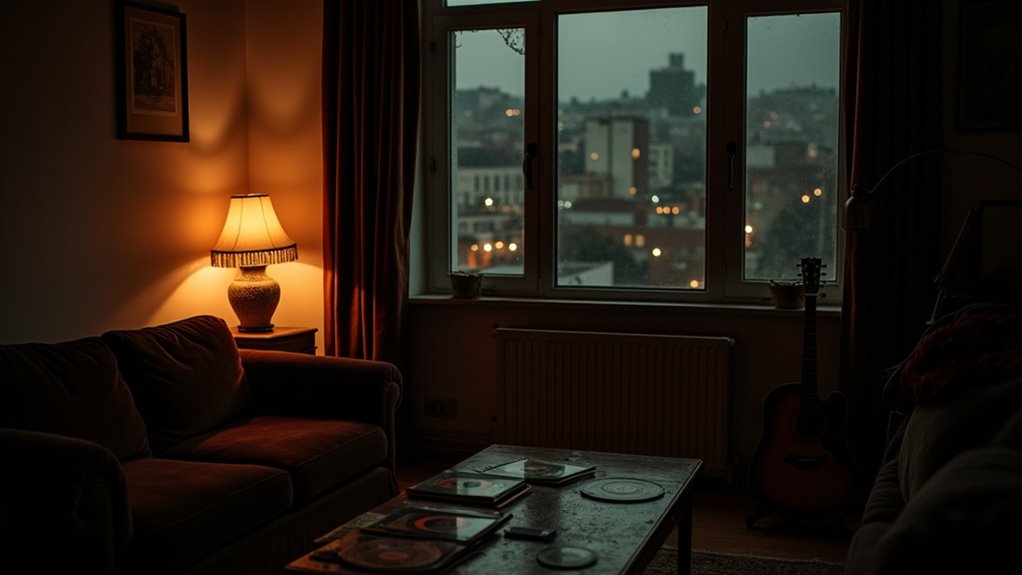The Kinks’ “Turn Off the Living Room Light” reveals seven key insights: it critiques superficiality through harsh physical descriptors, employs satirical humor rooted in British Music Hall tradition, uses irony to mask insecurities, reflects societal obsession with appearances, serves as a metaphor for hiding flaws, offers a detached yet vulnerable narrative, and blends raw rock with cabaret flair. Its layered commentary on human perception and societal norms invites a closer look for deeper understanding.
Key Takeaways
- The song critiques societal obsession with superficial appearances through satirical lyrics and humor.
- Turning off the light symbolizes masking flaws and escaping judgment in relationships.
- Ray Davies’ detached narrative reveals shared insecurities and human vulnerability.
- Its British Music Hall style blends irony with social commentary on perfection.
- Lyrics highlight superficiality’s impact on genuine emotional connections.
Exploring the Controversial Lyrics
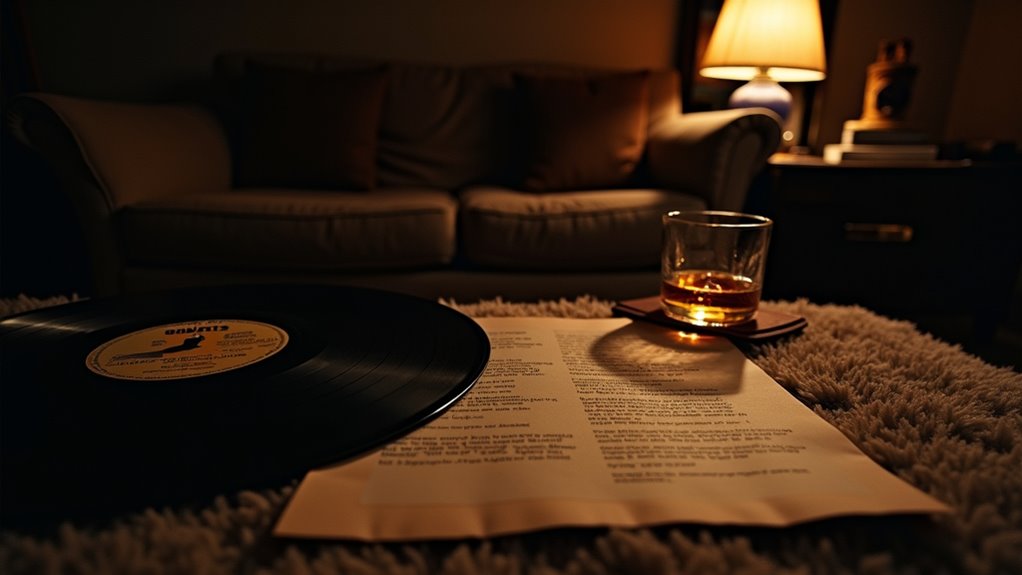
How does a song, tucked away in an unauthorized release, spark such intense debate over its lyrical content? The Kinks’ “When I Turn Off the Living Room Light,” featured on the unsanctioned “The Great Lost Kinks Album,” has ignited significant artistic controversy with its provocative lyrics.
Released by Reprise Records without the band’s consent, the track’s references to physical traits and ethnic descriptors, such as being “Jewish” alongside caricatured features, have drawn accusations of perpetuating cultural stereotypes. Some listeners find these depictions deeply unsettling, questioning Ray Davies’ intent, while others argue his use of stereotypes serves as social commentary through character sketches. Notably, many fans and experts assert that the song was intended as humorous satire, not a serious statement of prejudice.
This divide underscores a broader tension in interpreting artistic expression versus potential offense. The song’s unflattering focus on physical flaws further fuels discomfort, yet its unauthorized release context raises questions about whether these lyrics reflect Davies’ polished vision or an unfinished, misinterpreted work. Additionally, the album’s history of being pulled from distribution in 1975 after legal action by Ray Davies highlights the band’s strong disapproval of its release.
Unpacking the Satirical Humor
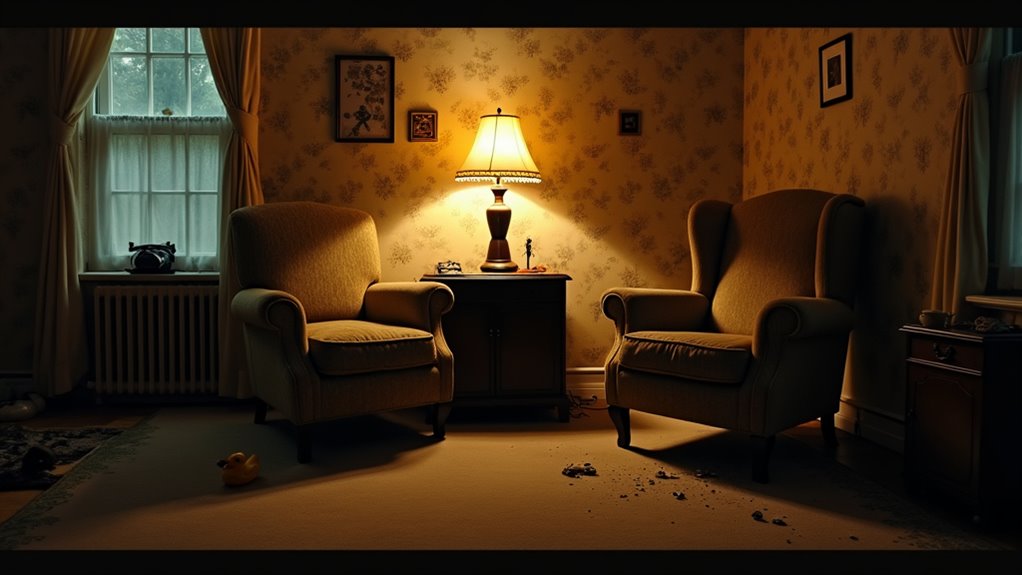
The satirical humor in The Kinks’ work, particularly in songs like “Turn Off the Living Room Light,” reveals a sharp intent to critique societal norms through wit and irony. By focusing on human flaws with exaggerated lyrical bluntness, Ray Davies crafts a comedic lens that exposes the superficiality of attraction while subtly embracing vulnerability.
This approach not only provokes laughter but also prompts reflection on the often unspoken truths of personal and relational imperfections.
Satirical Intent Explored
Why does “Turn Off the Living Room Light” by The Kinks resonate as both a novelty tune and a piercing social critique? Its blend of behavioral irony and cultural satire, rooted in Ray Davies’ sharp observations, exposes superficiality in relationships through humor. The lyrics, steeped in British Music Hall tradition, use theatrical exaggeration to mock romantic idealism, suggesting dimmed lights hide harsh truths.
| Visual Element | Satirical Implication |
|---|---|
| Dimmed living room | Illusion of romantic perfection |
| Bulbous nose | Absurd focus on physical flaws |
| Wrinkled, tight skin | Societal pressure on appearance |
| Flickering light switch | Deception in intimate connections |
This layered approach, while controversial in parts, critiques self-deception and societal norms, balancing novelty with profound commentary on human nature.
Humor in Flaws
What drives the satirical humor in The Kinks’ “Turn Off the Living Room Light” to strike such a peculiar chord? It lies in the song’s sharp blend of visual humor and societal critique, exposing human insecurities with unflinching wit.
Ray Davies’ lyrics dissect physical flaws—bulbous noses, spotty faces—with dark comedy, rendering them irrelevant in darkness.
Key elements of this humor include:
- Blunt descriptions of “ugliness” for comedic effect.
- Exaggerated stereotypes as narrative tools.
- Absurd solutions like darkness to mask flaws.
- Self-deprecating tones reflecting universal awkwardness.
- Dark honesty in addressing unspoken truths.
This approach critiques societal obsession with beauty, using visual humor to highlight shared human miseries, making the song a piercing yet relatable commentary on pretense and acceptance.
Examining Superficiality and Self-Deception
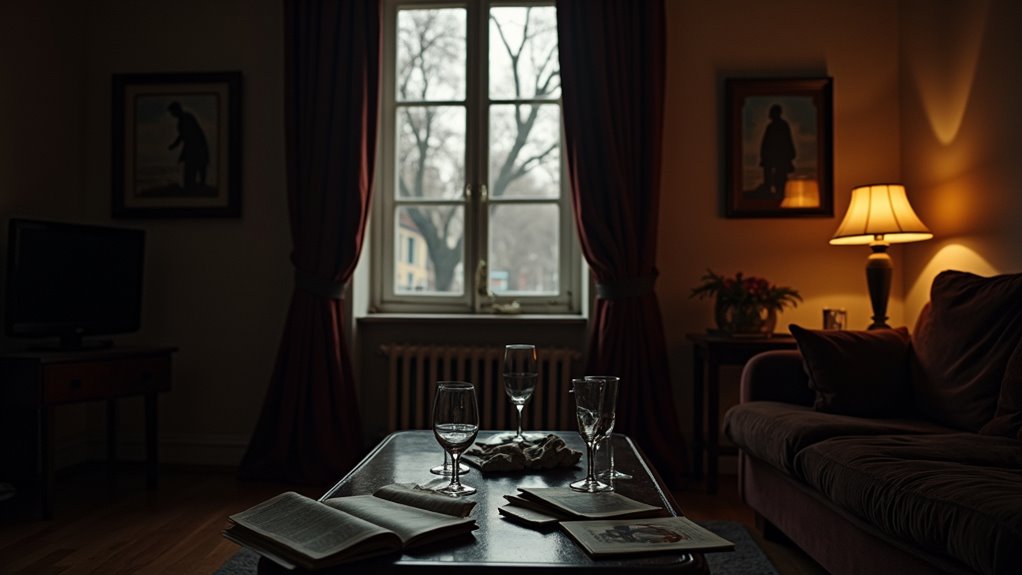
In exploring the themes of superficiality and self-deception within The Kinks’ “Turn Off the Living Room Light,” one observes how judging surface appearances dominates the speaker’s perspective, prioritizing visual flaws over deeper connection.
This fixation reveals a tendency to hide true feelings, as the act of extinguishing the light becomes a shield against confronting uncomfortable realities about both self and partner.
Such behavior underscores a broader commentary on how individuals may obscure authenticity to maintain a fragile, surface-level comfort in relationships.
Judging Surface Appearances
Several profound themes emerge when exploring the concept of judging surface appearances, a topic deftly examined through the lens of superficiality and self-deception in The Kinks’ music.
Their lyrics, notably in “Dedicated Follower of Fashion,” offer a sharp fashion critique, exposing authenticity issues as characters obsess over image rather than substance. This preoccupation with outward presentation often masks inner realities, reflecting societal pressures to conform.
Key insights into this theme include:
- Obsession with material possessions over personal depth.
- Misjudgment of character based on superficial traits.
- Reinforcement of harmful stereotypes through surface bias.
- Loss of genuine human connection due to pretense.
- Cultural critique of consumerism driving shallow values.
The Kinks thus illuminate the perils of valuing appearances over truth.
Hiding True Feelings
Beyond the critique of surface judgments, The Kinks probe deeper into the human psyche by exploring the act of hiding true feelings through superficiality and self-deception. In “When I Turn Off the Living Room Light,” turning off the light symbolizes psychological masking, shielding emotional vulnerability from harsh truths.
| Theme | Insight |
|---|---|
| Escapism | Darkness hides uncomfortable realities. |
| Mutual Illusion | Both parties embrace a shared pretense. |
| Physical Flaws | Superficial flaws vanish in the dark. |
| Emotional Shield | Inner anxieties are temporarily buried. |
This deliberate act offers fleeting comfort, yet underscores a poignant avoidance of genuine connection. Ray Davies’ delivery blends humor with pathos, revealing the bittersweet nature of masking one’s true self in darkness.
Understanding the Release Context
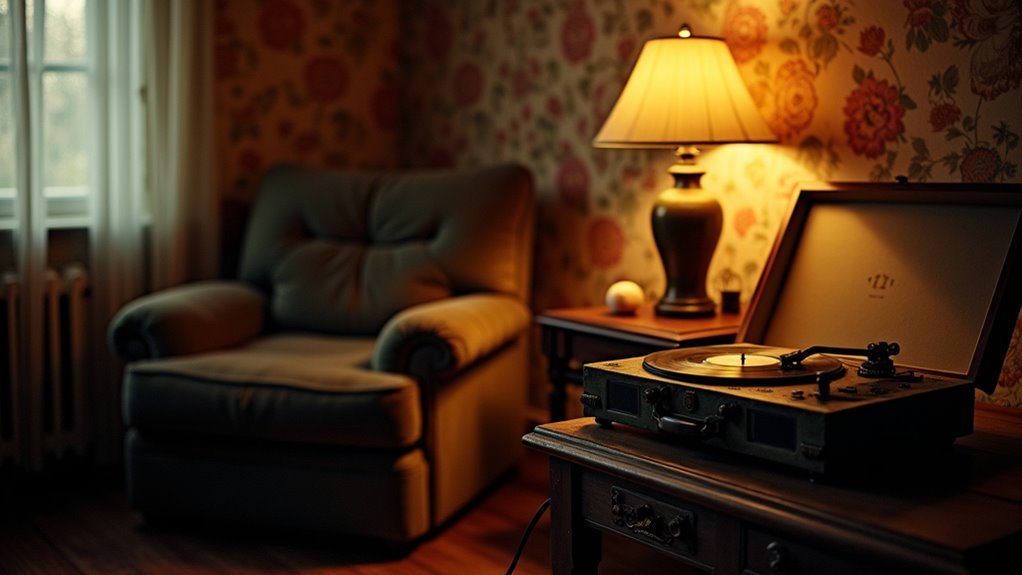
How did the release context of “When I Turn Off the Living Room Light” by The Kinks reflect the band’s unique trajectory during a pivotal era? Recorded in 1969 at BBC’s Riverside Sound Studios, this track emerged during the “Arthur” album sessions, a concept work marking their shift to nuanced, English-themed music. Though not included on “Arthur,” its eventual US release in 1973 on “The Great Lost Kinks Album” highlighted its status as a hidden gem from a transformative period.
The context reveals deeper layers of the band’s evolution:
- Recorded amidst the “Arthur” era, showcasing their thematic depth.
- Originated from a BBC session, reflecting unique recording settings.
- Released post-US tour ban lift, aligning with renewed visibility.
- Captured during lineup changes, mirroring internal transitions.
- Surfaced in a compilation, underscoring overlooked tracks.
This release context encapsulates The Kinks’ innovative spirit amid 1969’s diverse musical landscape and personal reinvention.
Analyzing the Narrative Perspective
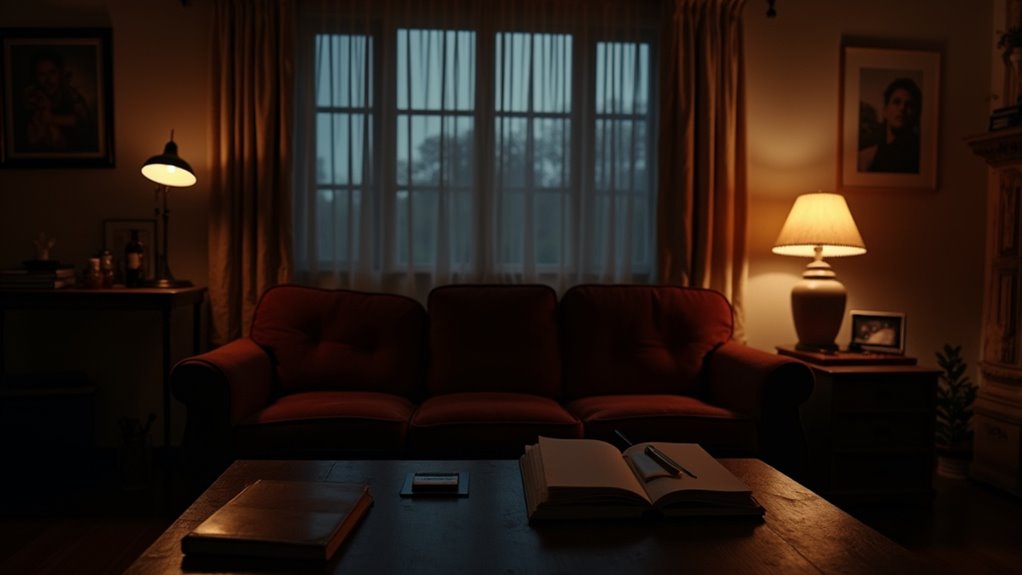
Introspection permeates the narrative perspective of “When I Turn Off the Living Room Light” by The Kinks, revealing a complex interplay of insecurity and perception through Ray Davies’ crafted persona. The narrative voice, delivered with a mix of detachment and subtle sadness, constructs a character perspective that oscillates between satire and vulnerability.
This narrator, possibly a fictional construct for a TV show, addresses a romantic “you” with unflattering descriptors—bulbous, spotty, wrinkled—yet deems them “gorgeous” in darkness.
Turning off the light becomes a metaphorical and literal escape, obscuring harsh judgments of appearance. The narrator’s motivation hints at shared inadequacy, as “we” feel less ugly in the dark, suggesting a poignant commentary on superficiality.
This character perspective offers no permanent resolution, only a cyclical reprieve from self-loathing. Davies’ nuanced portrayal thus captures a deeply human struggle with perception, masked by humor and irony.
Reviewing the Musical Style
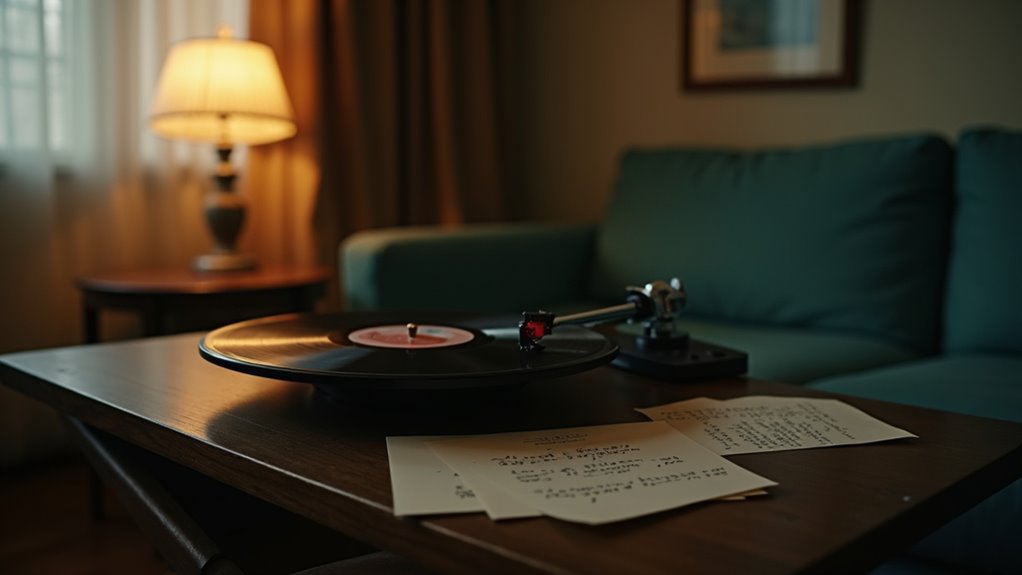
What defines the musical style of The Kinks’ “When I Turn Off the Living Room Light”? This track, recorded between 1967 and 1968, embodies a genre classification rooted in classic rock and rock & roll, infused with The Kinks’ distinct Brit-pop flair.
Its “loose-limbed and garagey” sound, alongside a music hall-inspired “Twenties cabaret send-up,” showcases their defiance of contemporary trends.
The instrumentation analysis reveals a basic setup of guitar, bass, and drums, with Ray Davies’ continuous, detached vocal delivery dominating the arrangement, lacking breaks or solos.
Key elements of its musical identity include:
- A vocally driven structure with minimal instrumental hooks.
- Ray Davies’ melodic yet childlike songwriting approach.
- A threadbare, poorly mixed production as per some critiques.
- Potential keyboard contributions from Nicky Hopkins, typical of this era.
- Mick Avory’s ferocious drumming style adding subtle rhythmic intensity.
This blend crafts a uniquely raw, nostalgic soundscape.
Connecting to Broader Themes
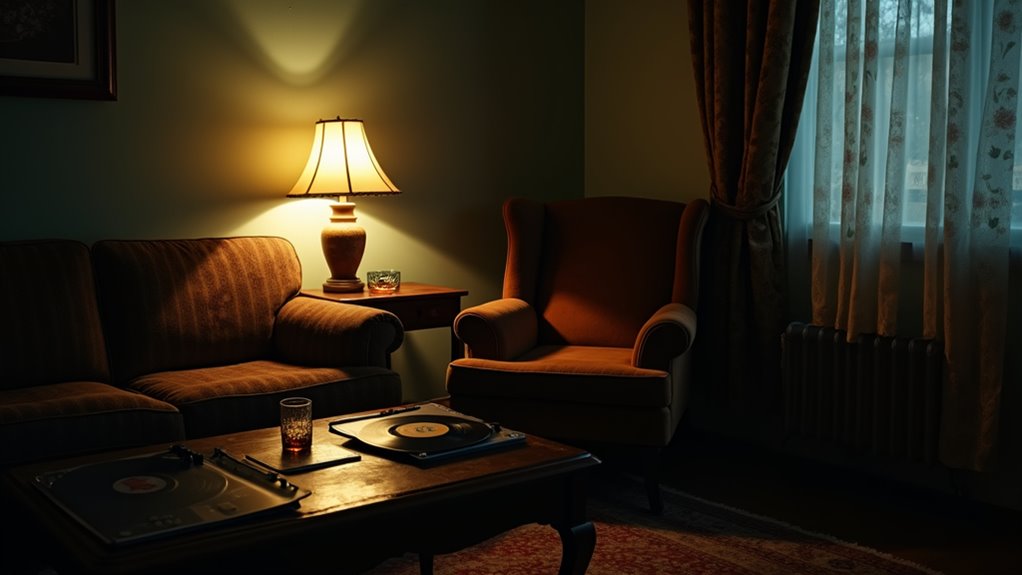
Why do The Kinks’ songs resonate so deeply beyond their musical style? Their lyrics, including those in “When I Turn Off the Living Room Light,” connect to universal struggles through sharp generational commentary and class critique. They reflect anxieties about modernity, nostalgia for simpler times, and the search for solace in domesticity or escapism, critiquing societal norms and superficiality.
The following table highlights key thematic intersections:
| Theme | Generational Commentary | Class Critique |
|---|---|---|
| Modernity | Fear of technological control | Bureaucracy burdens the ordinary |
| Nostalgia | Longing for past societal values | Elites erase working-class roots |
| Domesticity/Escapism | Retreat from modern pressures | Safe spaces defy social hierarchy |
These themes weave a tapestry of disillusionment with progress and status, while offering a lens on everyday life. The Kinks’ ability to voice such critiques ensures their work transcends mere sound, striking chords across generations and social strata.
